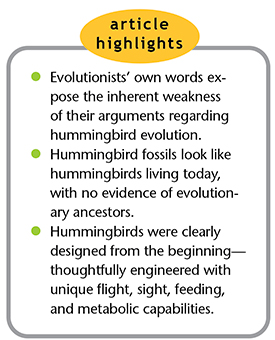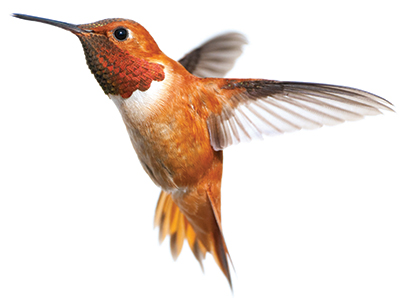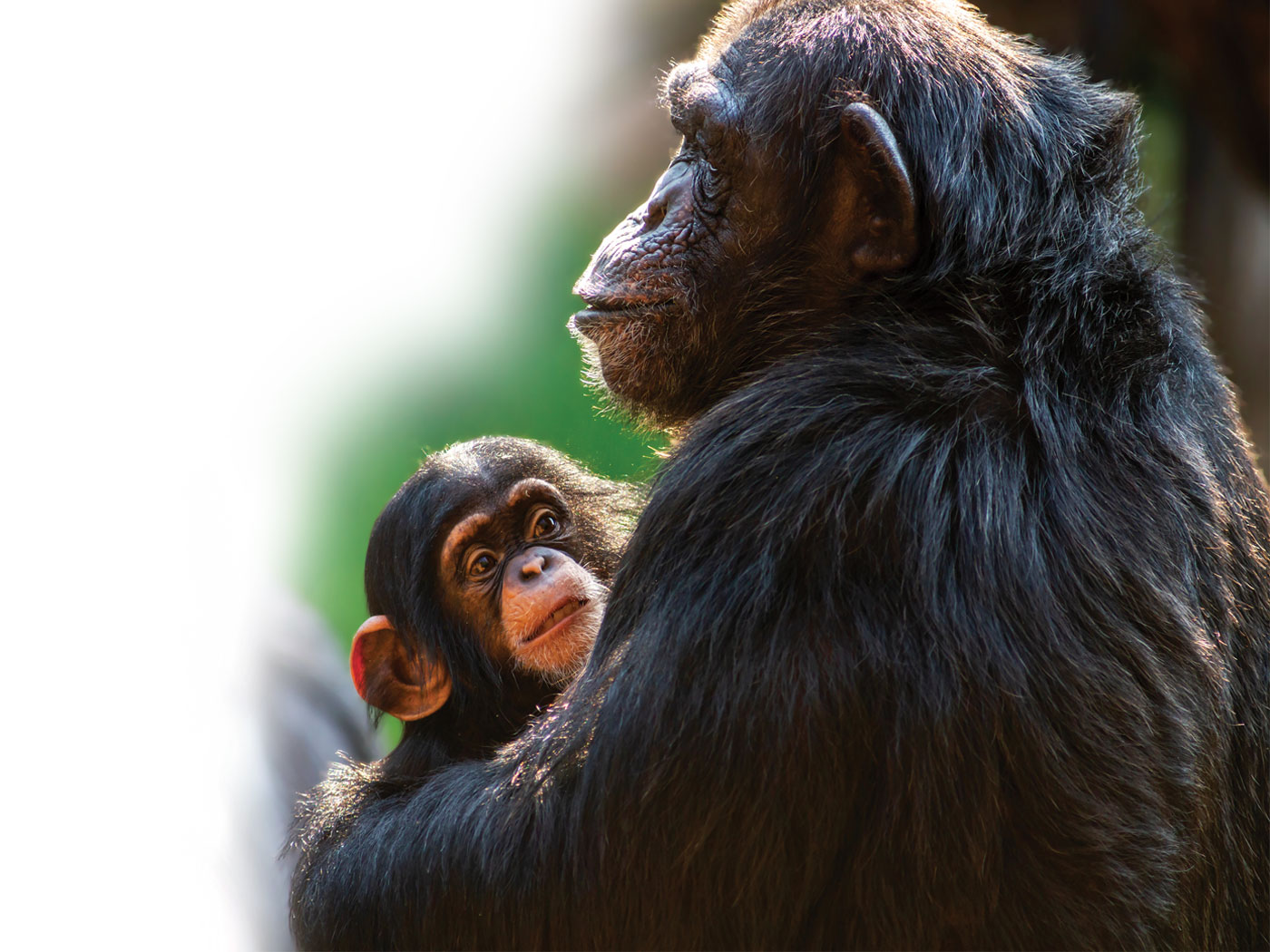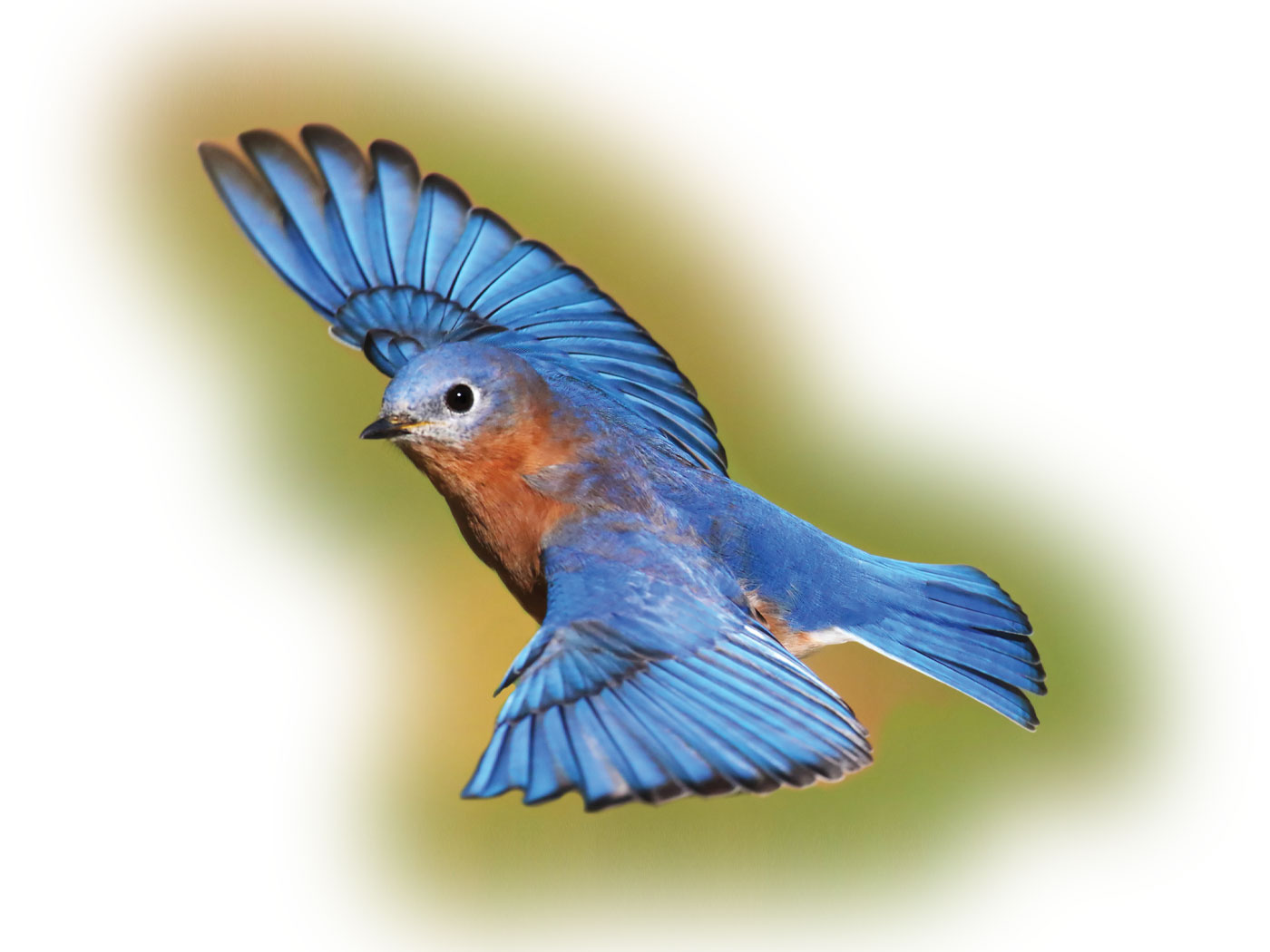 Zoologists have wonder and appreciation for the animals they investigate, whether the creatures fly through air, swim in water, or walk on land. Stanford University biologist Vadim Pavlov stated it best: “Animals are exciting sources of elegant engineering solutions in aero and hydrodynamics.”1
Zoologists have wonder and appreciation for the animals they investigate, whether the creatures fly through air, swim in water, or walk on land. Stanford University biologist Vadim Pavlov stated it best: “Animals are exciting sources of elegant engineering solutions in aero and hydrodynamics.”1
This is certainly true regarding the hummingbird, an amazing feathered acrobat, tiny and fearless. Many scientists attempt to explain hummingbirds’ profound innate engineering in Darwinian terms, but the evolutionists’ own explanations reveal the flaws in their logic.
Of all the birds of God’s creation, the hummingbird (“hummer”) might be the most remarkable. Everything about these creatures shouts design.2 Their little hearts can beat more than 1,000 times a minute, while their wings beat from 50 to 80 times a second. But evolutionists see hummingbirds as “diversifying and evolving over millions of years” and marvel that “evolution can take an animal to such extremes.”3
Evolutionary theory maintains these tiny birds evolved from a non-hummingbird ancestor. According to a study led by UC Berkeley herpetologist Jimmy McGuire:
The branch leading to modern hummingbirds arose about 42 million years ago when they split from their sister group, the swifts and treeswifts. This probably happened in Europe or Asia, where hummingbird-like fossils have been found dating from 28-34 million years ago.3
But when we look at the fossil record, we find that hummingbirds have always been hummingbirds. An article in the Journal of Ornithology validates this:
A near-complete, partially articulated skeleton of a hummingbird was recently found in the menilite shales of the Polish Flysh Carpathians. The specimen is dated to the Early Oligocene [about 33 million years ago]. It shares derived characters [traits absent in the last common ancestor] with extant [living] hummingbirds and plesiomorphic characters with swifts.4
 The same article also identified the Oligocene fossil “as a new species of the same genus [Eurotrochilus].”4 In other words, the fossil was still very much a hummingbird. The journal Science also described “tiny skeletons of stem-group hummingbirds from the early Oligocene of Germany that are of essentially modern appearance and exhibit morphological specializations toward nectarivory and hovering flight.” The paper referred to these as “the oldest fossils of modern-type hummingbirds, which had not previously been reported from the Old World.”5
The same article also identified the Oligocene fossil “as a new species of the same genus [Eurotrochilus].”4 In other words, the fossil was still very much a hummingbird. The journal Science also described “tiny skeletons of stem-group hummingbirds from the early Oligocene of Germany that are of essentially modern appearance and exhibit morphological specializations toward nectarivory and hovering flight.” The paper referred to these as “the oldest fossils of modern-type hummingbirds, which had not previously been reported from the Old World.”5
Evolutionists believe the hummer somehow evolved from Archosauria (class Reptilia), the group that includes crocodiles and alligators. However, the fossil record doesn’t document this at all. The alleged common ancestor of hummingbirds remains unknown.
Hummingbirds and Flowers
Many are familiar with the relationship between the hummer and flowers they feed on and pollinate. These flowers seem uniquely designed to accommodate a hummingbird’s beak and tongue, but did such a relationship evolve? A study published in Integrative Organismal Biology stated: “The fit between flowers and hummingbird bills has long been used as an example of impressive co-evolution.”6
Yet co-evolution is hardly an impressive explanation because it isn’t scientific. Two evolutionists describe co-evolution as being “caused by selection pressures” that each species somehow enacts on the other.7 Selection pressure is supposedly exerted by the environment. But the environment can’t apply pressure. Nature can’t think and select—it just exists. For example, when it comes to bird vision switching between violet and ultraviolet wavelengths “in the course of avian evolution,” it isn’t surprising that evolutionary scientists admit “the selection pressures driving this switch are not well understood.”8
God designed the hummingbird’s bill and tongue to drink nectar from flowers many insects wouldn’t be able to access. Just as hummingbirds have always been hummingbirds, we find that flowers (angiosperms) have always been flowers as God created them. They didn’t evolve. Two separate published studies powerfully summarized the “mystery” of the origin of flowers. One stated: “The question of the structure and biology of the ancestral angiosperms, and especially their flowers, is an enduring riddle.”9 The other study’s lead author observed that “the discrepancy between estimates of flowering plant evolution from molecular data and fossil records has caused much debate.”10
Most of us don’t appreciate the complexity of what happens when a hungry hummer feeds from a flower or man-made feeder. High-speed filming and detailed anatomical studies revealed the birds are designed with a long, forked tongue that aids in drinking biomechanics. The tongue opens up when inserted into the flower, and the nectar is pumped up the tongue via two grooves. The hummer can do this up to 20 times per second.
Because of this speed, scientists realized the traditional explanation of nectar being drawn up by capillary action (the movement of a liquid in a narrow space caused by the surface tension of the liquid—adhesion and cohesion) was incorrect. It was wrongly assumed for almost two centuries that hummingbirds took in nectar by capillary rise loads. Although the hummingbird’s amazing feeding mechanism has now been shown, evolutionists maintain that its tongue’s abilities—no matter how complex—evolved. “Nectarivores [nectar-eating organisms], however, have evolved specialized tongues that function as their primary food-capturing device.”11 But “have evolved” isn’t a scientific explanation. (The same article stated, “The tetrapod tongue evolved.”) Creationists assert that hummers, like woodpeckers, were designed with specialized tongues from the beginning.
Hummingbird feeding appears to be irreducibly complex—a phrase non-evolutionists use to explain the way in which a number of crucial parts must all work together for a structure or process to function. In this case, it starts with the tongue fitting the flower. According to a New York Times report on hummingbird tongue research:
The findings could affect thinking about how flowers and hummingbirds have evolved together, since the shape of the flower, the composition of the nectar and the shape and workings of the tongue must all fit together for the system to work.12
Nectar taken into the hummingbird’s body is immediately metabolized (burned) for energy to power rapid wing strokes. Sugars are compounds rich in energy. Evolutionists say, “Whereas humans evolved over time on a complex diet, hummingbirds evolved on a diet rich in sugar.”13 But hummingbirds and people haven’t evolved from ancient bird and human ancestors. It’s far more accurate to say humans are designed to metabolize a complex diet, whereas hummingbirds are designed to metabolize a diet rich in sugar.
Because of their immediate energy needs, God designed hummingbirds to process the monosaccharides fructose and glucose with ease. When chemically hooked together, these make up the disaccharide sucrose, or table sugar. University of Toronto biologist Kenneth Welch stated:
What’s very surprising is that unlike mammals such as humans, who can’t rely on fructose to power much of their exercise metabolism, hummingbirds use it very well. In fact, they are very happy using it and can use it just as well as glucose.13
Hummingbird Vision
Hummingbird vision is also a marvel. The Creator designed hummingbirds with a color vision range that exceeds that of humans. This unique vision helps birds see nectar-producing plants, potential mates, predators, and objects within their range.
Recent research verifies this amazing fact. In addition to the three types of color cones humans have in their eyes, birds have one more. Not only are they sensitive to red, green, and blue light, they also can pick up on ultraviolet rays.14 In a Princeton University news release, evolutionary biologist Mary Caswell Stoddard said:
Not only does having a fourth color cone type extend the range of bird-visible colors into the UV [ultraviolet], it potentially allows birds to perceive combination colors like ultraviolet+green and ultraviolet+red—but this has been hard to test.14
The release went on to state, “Stoddard and her colleagues designed a series of experiments to test whether hummingbirds can see these nonspectral colors,” the results of which were published in the Proceedings of the National Academy of Sciences.14 And indeed, the hummingbird’s fourth color cone type allows it to see colors we cannot even imagine! In their study, Stoddard’s team reported:
Nonspectral colors are perceived when nonadjacent cone types (sensitive to widely separated parts of the light spectrum) are predominantly stimulated. For humans, purple (stimulation of blue- and red-sensitive cones) is a nonspectral color; birds’ fourth color cone type creates many more possibilities.15
An earlier study conducted by the Washington University School of Medicine in St. Louis reported:
The researchers characterized the carotenoid pigments from birds with violet vision and from those with UV vision and used computational models to see how the pigments affect the number of colors they can see....The study also revealed that sensitivity of the violet/UV cone and the blue cone in birds must move in sync to allow for optimum vision. Among bird species, there is a strong relationship between the light sensitivity of opsins [a protein contained in vertebrates’ visual pigment that determines the pigment’s spectral sensitivity] within the violet/UV cone and mechanisms within the blue cone, which coordinate to ensure even UV vision.16
Was such intricate design of these cones caused by chance and time or plan and purpose?
Hummingbird Communication
Hummingbirds vocalize using high-pitched chirping. “Hummingbirds are a fascinating group of birds, but some aspects of their biology are poorly understood, such as their highly diverse vocal behaviors.”17 Like their vision, these birds’ vocalization is incredibly complex.
The predominant vocalization of black jacobins (Florisuga fusca) [a type of hummingbird]...consists of a triplet of syllables with high fundamental frequency (mean F0 ∼11.8 kHz), rapid frequency oscillations and strong ultrasonic harmonics and no detectable elements below ∼10 kHz. These are the most common vocalizations of these birds, and their frequency range is above the known hearing range of any bird species recorded to date, including hearing specialists such as owls. These observations suggest that black jacobins either have an atypically high frequency hearing range, or alternatively their primary vocalization has a yet unknown function unrelated to vocal communication. Black jacobin vocalizations challenge current notions about vocal communication in birds.17
Hummingbird Physiology
Animals can make physiological adjustments to slow down their metabolism, and this can affect body temperature. For example, hummingbirds do this on cold nights to save energy. A recent investigation added another layer to the astounding feats of these tiny marvels:
Researchers sought to learn more about several of the species of hummingbirds that live in the Andes in South America—a region that can get very cold at night in the summer. In this case, the researchers looked at species that survive at altitudes up to 3,800 meters above sea level....The researchers also found that one of the birds, a black metal tail, lowered its body temperature to just a few degrees above freezing—to 3.3 degrees C. This finding marked a record low body temperature for any non-hibernating mammal.18
The wonderful, created hummingbird is a miracle. Its specialized interaction with plants, visual color range, complex vocalization, and unique flight and physiological capabilities are a testament to God’s living creation design.
References
- Kubota, T. Stanford researchers discover biological hydraulic system in tuna fins. Stanford News Service. Posted on news.stanford.edu July 20, 2017, accessed September 8, 2020.
- Thomas, B. 2016. Hummingbirds! Acts & Facts. 45 (4): 16.
- Michelson, M. Hummingbird Evolution. California Academy of Sciences. Posted on calacademy.org April 9, 2014, accessed September 8, 2020.
- Bochenski, Z. and Z. Bochenski. 2008. An Old World hummingbird from the Oligocene: A new fossil from Polish Carpathians. Journal of Ornithology. 149 (2): 211-216.
- Mayr, G. 2004. Old World Fossil Record of Modern-Type Hummingbirds. Science. 304 (5672): 861-864.
- Rico-Guevara, A. et al. 2019. Shifting Paradigms in the Mechanics of Nectar Extraction and Hummingbird Bill Morphology. Integrative Organismal Biology. 1 (1): oby06.
- Thain, M. and M. Hickman. 2004. The Penguin Dictionary of Biology. New York: Penguin Books, 161.
- Toomey, M. B. et al. Complementary shifts in photoreceptor spectral tuning unlock the full adaptive potential of ultraviolet vision in birds. eLife. Posted on elifesciences.org July 12, 2016, accessed September 8, 2020.
- Endress, P. K. and J. A. Doyle. 2009. Reconstructing the ancestral angiosperm flower and its initial specializations. American Journal of Botany. 96 (1): 22-66.
- When did flowers originate? University College London news release. Posted on ucl.ac.uk February 5, 2018, accessed September 8, 2020.
- Rico-Guevara, A. and M. A. Rubega. 2011. The hummingbird tongue is a fluid trap, not a capillary tube. Proceedings of the National Academy of Sciences. 108 (23): 9356-9360.
- Gorman, J. The Hummingbird’s Tongue: How It Works. The New York Times. Posted on nytimes.com September 8, 2015, accessed September 14, 2020. Emphasis added.
- Hummingbird metabolism unique in burning glucose and fructose equally. University of Toronto media release. Posted on media.utoronto.ca December 5, 2013, accessed September 8, 2020.
- Fuller-Wright, L. Wild hummingbirds see a broad range of colors humans can only imagine. Princeton University news release. Posted on princeton.edu June 15, 2020, accessed September 8, 2020.
- Stoddard, M. C. et al. 2020. Wild hummingbirds discriminate nonspectral colors. Proceedings of the National Academy of Sciences. 117 (26): 15112-15122.
- How birds unlock their super-sense, ultraviolet vision. eLife. Posted on elifesciences.org July 12, 2016, accessed September 8, 2020.
- Olson, C. R. et al. 2018. Black Jacobin hummingbirds vocalize above the known hearing range of birds. Current Biology. 28 (5): R204-R205.
- Yirka, B. Hummingbird reduces its body temperature during nightly torpor. Phys.org. Posted on phys.org September 9, 2020, accessed September 10, 2020.
* Mr. Sherwin is Research Associate at the Institute for Creation Research and earned his M.A. in zoology from the University of Northern Colorado.





















